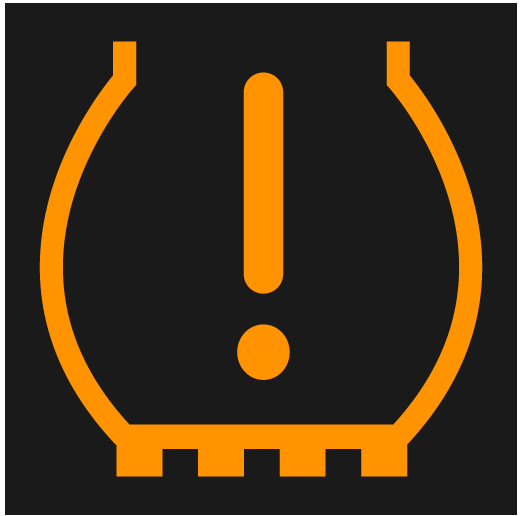

Check and rectify the inflation pressure when the indicator symbol for the system illuminates and a low inflation pressure message is shown.
- Switch off the ignition.
- Check the inflation pressure on all four tires using a tire pressure gauge.
- Inflate the tire to the correct inflation pressure; see the tire pressure placard on the driver’s side B pillar for recommended pressures for factory-mounted tires.
- After the inflation pressure has been adjusted, always save the new inflation pressure in the system via the center display.Please be aware that the indicator symbol will not go out until the low tire pressure has been corrected and a storing procedure has been started for the new inflation pressure.The vehicle needs to be driven for a few minutes at a speed above 22 mph (35 km/h) for the system to be able to store the new reference value.
To help prevent incorrect inflation pressure, pressure should be checked when the tires are cold. The tires are considered to be cold when they have reached the same temperature as the ambient temperature (about 3 hours after the vehicle was last driven). After driving for a few kilometers, the tires will warm up and the pressure will increase.
- After inflating a tire, always replace the valve cap to help prevent valve damage caused by gravel, dirt, etc.
- Only use plastic valve caps or original Polestar valve caps.
- Incorrect inflation pressure could lead to tire failure, which could cause the driver to lose control of the vehicle.
- The system cannot predict sudden tire damage.
Saving new reference values for tire inflation pressure monitoring
- In order for the tire pressure monitoring system to function correctly, tire pressure reference values must be saved correctly. To help ensure that the system can correctly alert the driver of low inflation pressure, this must be done each time the tires are changed or the inflation pressure is adjusted.
- For example, when driving with a heavy load or at high speeds (over 160 km/h (100 mph)), tire inflation pressure should be adjusted to the Polestar-recommended inflation pressure values. The system should then be reset by saving the new inflation pressure.
To store the new inflation pressure as a reference value in the system:
- Switch off the ignition.
- Inflate the tire to the correct inflation pressure; see the tire pressure placard on the driver’s side B pillar for recommended pressures for factory-mounted tires.
- Start the vehicle.
- Tap
- Tap More.
- Tap Car status.
- Tap Store pressure.
If the pressure cannot be stored, a message will appear.
Tire pressure monitoring messages
| Center display: Storing pressure required due to updated software | The software has been updated and the tire inflation pressure needs to be saved again. Check the tire inflation pressure and fill as needed. |
| Instrument panel: Tire pressure low Check Car Status app in center display | The indicator symbol will illuminate to indicate that inflation pressure is low in one or more tires. See vehicle status in the center display for more information. |
| Instrument panel: Tire pressure system Temporarily unavailable | The indicator symbol will flash for about 1 minute and then glow steadily. The system is temporarily unavailable and will be activated momentarily. |
| Instrument panel: Tire pressure system Service required | The indicator symbol will flash for about 1 minute and then glow steadily. The system is not functioning correctly. Contact Polestar Customer Support. |
Tire pressure monitoring system
This symbol illuminates to indicate low inflation pressure. Check the tire inflation pressure in the center display by tapping
If there is a system malfunction, the inflation pressure warning symbol will flash for approximately one minute and then glow steadily.
System descriptionThe tire pressure monitoring system measures differences in rotational speed between the wheels through the ABS system to determine if the tires are properly inflated. If inflation pressure in a tire is too low, its diameter (and consequently its rotational speed) changes. By comparing the tires with each other, the system can determine if the pressure in one or more tires is too low.
General information about the tire pressure monitoring systemIn the following description, the tire monitoring system is generally referred to as TPMS.
Each tire, including the spare, should be checked monthly when cold and inflated to the inflation pressure recommended by the vehicle manufacturer on the vehicle placard or tire inflation pressure label. (If your vehicle has tires of a different size than the size indicated on the vehicle placard or tire inflation pressure label, you should determine the proper tire inflation pressure for those tires.)
As an added safety feature, your vehicle has been equipped with a tire pressure monitoring system (TPMS) that illuminates a low tire pressure telltale when one or more of your tires is significantly under-inflated. Accordingly, when the low tire pressure telltale illuminates, you should stop and check your tires as soon as possible, and inflate them to the proper pressure.
Driving on a significantly under-inflated tire causes the tire to overheat and can lead to tire failure. Under-inflation also reduces fuel efficiency and tire tread life, and may affect the vehicle’s handling and stopping ability. Please note that the TPMS is not a substitute for proper tire maintenance, and it is the driver’s responsibility to maintain correct tire pressure, even if under-inflation has not reached the level to trigger illumination of the TPMS low tire pressure telltale.
Your vehicle has also been equipped with a TPMS malfunction indicator to indicate when the system is not operating properly. The TPMS malfunction indicator is combined with the low tire pressure telltale. When the system detects a malfunction, the telltale will flash for approximately one minute and then remain continuously illuminated. This sequence will continue upon subsequent vehicle start-ups as long as the malfunction exists. When the malfunction indicator is illuminated, the system may not be able to detect or signal low tire pressure as intended.
TPMS malfunctions may occur for a variety of reasons, including the installation of replacement or alternate tires or wheels on the vehicle that prevent the TPMS from functioning properly.
Always check the TPMS malfunction telltale after replacing one or more tires or wheels on your vehicle to ensure that the replacement or alternate tires and wheels allow the TPMS to continue to function properly.
To keep in mind
- Always save the new inflation pressure in the system after changing a tire or adjusting the inflation pressure.
- Using snow chains can affect tire inflation pressure monitoring. This is indicated by a symbol and message in the instrument panel. When the snow chains are removed, all tires should be checked and adjusted to the recommended inflation pressure. The new inflation pressure should then be saved in the tire pressure monitoring system.
- If you switch to a tire of another size than the factory-mounted tires, the system must be reset by storing a new inflation pressure for these tires to avoid false warnings.
- If a spare wheel is used, it is possible that the tire pressure monitoring system will not work correctly due to the differences between the wheels.
- The system does not replace the need for regular tire inspection and maintenance.
- It is not possible to deactivate the tire pressure monitoring system.
- Incorrect inflation pressure could lead to tire failure, which could cause the driver to lose control of the vehicle.
- The system cannot predict sudden tire damage.
Viewing tire pressure status in the center display
Checking status
The vehicle may need to be driven for a few minutes at a speed above 35 km/h (22 mph) to activate the system.
- Tap
- Tap More.
- Tap Car status to see tire inflation pressure status.





